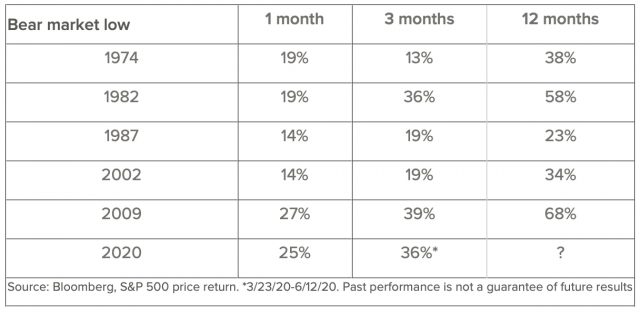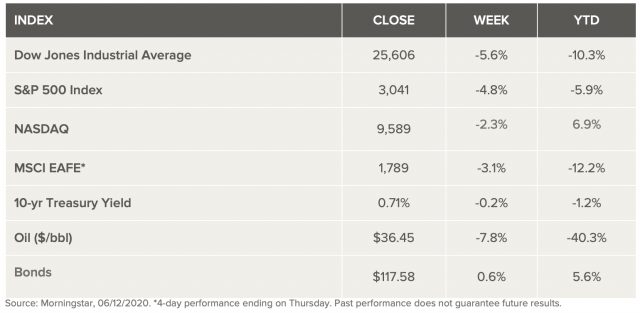Stock Markets
Stocks logged their worst weekly decline since March as fears of a second wave of infections and doubts about a speedy economic recovery dampened investor sentiment. The Federal Reserve indicated that rates are likely to remain near zero until 2022 and issued a cautious economic outlook. The Fed’s cautious tone, in combination with news of an acceleration in new infections and hospitalizations in certain states as well as concerns about the speed of the rebound in stocks, triggered some profit-taking. Analysts believe volatility will likely continue as uncertainties remain, but a longer-term economic recovery is starting to take shape.
U.S. Economy
After a historic drive higher from a late March low, the market sputtered last week, the first real sign of fatigue since stocks began their rebound. The market recorded its first three-day losing streak since February, including its worst daily drop in three months. Has the recovery run out of gas, or is this just a pit stop?
Analysts don’t think this signals a return to the market environment we experienced in February and March. At the same time, sufficient risks still remain, and even the best market rallies need a breather.
History shows that the initial stages of new bull markets are typically characterized by strong gains, a positive sign for the current rally. The table below shows how the recent rally stacks up to historical bull market commencements. There is no guarantee we’ve reached the lows in this current phase, but analysts point out an encouraging signal: While strong rallies often occur within ongoing bear markets, in the postwar era, every instance in which the stock market rose more than 30% from a bear market low turned out to be the beginning of a new bull market.
Stock Market Performance

Metals and Mining
Surging 2.8 percent this week off renewed COVID-19 concerns and weak economic data from the US, gold is on track for its largest weekly gain since the first week of April. Dismal data from the World Bank forecasting a 5.2 percent global contraction in the wake of the pandemic saw support when the US Federal Reserve projected a 6.5 percent decline in the US economy. Another 1.5 million jobless claims in the US last week sent markets into a tailspin on Thursday as investors pulled back on optimism seen earlier in the month. The flurry of news sent gold as high as US$1,744 per ounce, but it then slid back to US$1,724 in pre-trading hours on Friday. Despite the recent price volatility, the yellow metal is the lone resource expected to climb in 2020, according to the World Bank’s report. Calling this the worst recession since World War II, the international monetary group warned that a second round of COVID-19 lockdowns could lead to an even greater decline (8 percent) and prevent a forecasted 2021 recovery. Midway through the week, US Federal Reserve Chair Jerome Powell promised to counter the prolonged economic impact of coronavirus with continued stimulus, “using our full range of tools to support the economy in this challenging time.” During an interview, Byron King touched on the insurmountable level of US debt and his expectations for gold and the dollar.
In other precious metals, Silver also experienced uncertainty-related price growth early in the session, moving above US$18.15 per ounce. But safe haven demand was unable to hold the metal at US$18.10, and it fell back mid-week. A brief uptick on Thursday had silver testing US$18 again, before dipping as low as US$17.46 after hours. Following a steady decline in May, platinum prices edged to a four-week high on Wednesday. The metal’s climb to US$830 per ounce mid-week has been attributed to growing interest in platinum exchange-traded funds (ETFs). A recent five day stretch of consecutive inflows added 37,400 ounces of platinum to ETF holdings. Broad market pressure Thursday sent the platinum price below US$800 for the first time since June 5. Palladium fell to US$1,824 per ounce as markets dipped late in the week, its weakest since May 15. It continues to await a resurgence in automotive demand, which is expected to slowly increase in the weeks to come.
Base metals bore the brunt of the volatility, with all but copper ending the week lower. Copper was bolstered this session from China’s renewed industrial demand, a key factor for the growth of the base metals market. Entering the period at US$5,659 per tonne, the red metal climbed to US$5,680 on Wednesday and held. Slipping back from its Monday price of US$2,095 per tonne to hold at US$2,003.50, zinc was unable to make gains this session. Stagnated demand for the metal has kept prices low, although a 23,000 tonne shipment of zinc to the London Metal Exchange this week is offering promise. Speculation that a restart in the US auto sector could lead to an increase in demand for zinc and lead may be beneficial for prices in the near term. Nickel also fell off from its early week high of US$12,943 per tonne as continued drags on demand prevented growth. Electric vehicle adoption initiatives in Europe may be a potential catalyst for nickel down the road, despite the sector remaining flat currently.EV growth will put pressure on nickel sulfide companies, as the demand for the material from the electric vehicle battery space increases. Lead was also impacted by the fall in optimism and by fears a second wave of COVID-19 could again shutter economies. Slipping 1.5 percent this week, lead will face continued headwinds if industrial demand isn’t able to steadily climb in the months ahead.
Energy and Oil
Oil is set for the first weekly decline in over a month, dragged down by the broader selloff on Thursday. The jump in coronavirus cases in the U.S. sparked renewed concerns about the economic recovery. The Federal Reserve warned of long-term scars on the economy. At the same time, oil analysts have warned that the crude oil rally may have gone too far. U.S. gasoline demand ticked up to 7.9 mb/d in the first week of June, up about 350,000 bpd from a week earlier. Jet fuel demand is still a shadow of its former self, stuck at 30 to 40 percent of its pre-pandemic levels. Goldman Sachs said that an oil price correction of about 20 percent may already be underway. “Despite the rally, we have been hesitant to recommend a long position this early in the cycle for several reasons,” Goldman Sachs commodities analysts wrote in a note. Inventories are too high and the price rally has gone too far, the bank said. The Trump administration is planning to push for opening up Florida for offshore oil drilling, but the proposal will wait until after the November election in order to avoid political blowback, according to Politico. Drilling in Florida faces bipartisan opposition. The eastern Gulf of Mexico has long been off-limits to the industry. U.S. shale will concentrate on the Permian basin, where growth returns in 2021 and continues through 2030, according to Wood Mackenzie. Meanwhile, the Eagle Ford won’t return to its 2019 average until 2024, but will then decline. Projections vary, but the comeback is widely expected to be slow. Natural gas spot prices fell at most locations this week. The Henry Hub spot price fell from $1.77 per million British thermal units (MMBtu) last week to $1.70/MMBtu this week. At the New York Mercantile Exchange (Nymex), the price of the July 2020 contract decreased 4¢, from $1.821/MMBtu last week to $1.780/MMBtu this week. The price of the 12-month strip averaging July 2020 through June 2021 futures contracts declined 11¢/MMBtu to $2.332/MMBtu.
World Markets
Equities in Europe fell—snapping four weeks of gains—on fears of a resurgence of coronavirus infections and a delayed economic recovery. The pan-European STOXX Europe 600 Index ended the week 4.99% lower. Among European markets, Germany’s Xetra DAX Index fell 6.13%, France’s CAC 40 Index declined 6.05%, and Italy’s FTSE MIB Index dropped 5.77%. The UK’s FTSE 100 Index slid 4.89%.
Gross domestic product (GDP) in the UK shrank by a record 20.4% in April from March as the country spent the month in a coronavirus lockdown, official data showed. The economy contracted by 24.5% year on year. ONS Statistician Rob Kent-Smith noted that the economy in April was the same size as it was in 2002.
Bank of England (BoE) Governor Andrew Bailey said that there were some signs of an economic pickup as the lockdown restrictions began lifting in May, but he warned that there was still likely to be long-term economic damage. The BoE was expected to expand its bond-buying program the following week.
Stocks in China declined amid disappointing credit data and weaker global sentiment. The domestic large-cap CSI 300 Index was unchanged from the previous week, while the benchmark Shanghai Composite Index slipped 0.4%. China’s sovereign 10-year bond yield declined as inflation continued to slow and stayed below the government’s full-year target.
China’s broad credit growth, as measured by total social financing, rose to 12.5% year on year in May compared with 10.7% last December, though a surge in net issuance of government debt appeared to drive the increase. Analysts said that China’s strong credit growth could overstate the prospects for an economic recovery as it includes short-term corporate bonds and coronavirus relief loans from the central bank, in addition to new loan demand from enterprises and households.
The Week Ahead
Important economic data being released include retail sales on Tuesday, housing starts and building permits on Wednesday, and the leading index on Thursday.
Key Topics to Watch
- Empire State index
- Retail sales
- Retail sales ex-autos
- Industrial production
- Capacity utilization
- Home builders’ index
- Business inventories
- Housing starts (annual rate)
- Building permits (annual rate)
- Initial jobless claims (regular state program)
- Initial jobless claims (total, NSA)
- Philly Fed manufacturing index
- Leading economic indicators
- Current account deficit
Markets Index Wrap Up


